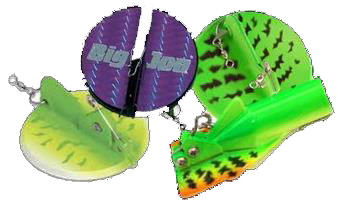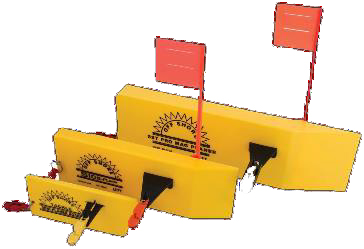Diving Planers and Discs behind Off-Shore Tackle inline planer boards

In all fishing situations, depth control is one of the most important factors in fishing success. Getting a lure to the right depth, often times into a range of only 2-3 feet, should be the anglers' primary focus after they find an area with feeding fish. Some of the most common depth control devices, especially for unweight lures like spoons and crawler harness, are diving planers and diving discs. Each type comes in several sizes and a few different styles.
The most popular diving planers are the "Run Down" made by Lurk and the Luhr-Jensen "Jet Diver", while there are several diving discs on the market including the Luhr-Jensen Dipsey Diver, the Big Jon Mini and Deeper Diver and the Lurk "Disco Diver".
I and several captains I know run both divers and diving planers on a regular basis on both the Great Lakes and inland lakes and have great success with them. We all run them behind the Off-Shore Tackle inline boards with great success. Here are a few tips for running diving planers and diving discs behind Off-Shore inline planer boards:

1) The shallower divers (shortest leads) should be on the outside with deeper ones on the inside. Any time you are setting "weighted" lures (divers, leadcore, inline weights, snap weights) always run the shallowest on the outside to deeper inside. I run my divers in either 5,10 or 20' increments (a spread may be outside diver 20' back, middle diver 25' back and inside 30' back) This allows me to catch a fish on the outside board and land it without having to clear the other rods. The weight of the fish causes the diver to stop "diving" and the diver and fish come over top of the deeper rods. When I reset the outside rod, I put the board on, free spool it straight out the back of the boat until it is the desired distance away from the boat (see tip #2) then engage the reel and put rod in the holder. The board and diver clear the other rods and go right back to the outside position.
2) I have OCD about how far from the boat my Off-Shore Inline planer boards run and want them to be exactly the same every time I run them out…I always run the outside board 100' from the boat, the middle board 75' and the inside 50' from the boat…the consistency makes it much easier to spot anything "different" on the boards

3) If you are getting tangles, realize that diving planers (jets and run downs) have a horizontal movement in the water (one of the things that makes them so effective pulling spoons) and need to be set carefully and kept at least 10-15' apart so they don't run into each other when they are "zinging" side to side
4) When I talk to anglers about Off-Shore Inline planer boards running too far behind the boat the first thing I ask about is where the rod holders are placed on the gunnels. The further forward they are on the gunnels, the less "sag" you will see. I run my rod holders right behind the driver and port side passenger seat…with this setup and the board set up in #2 my Off-Shore inline planer boards are in a line when I look out the boat from where I stand in the boat, usually right behind the driver's seat…moving your holders forward, even a few inches, will make a huge difference in where our Off-Shore boards run.
5) The higher you can get the rod tips above the water, the better your Off-Shore Inline planer boards will track of to the side. Keeping line off the water is an important part of getting the boards to run right. I like vertical rod holders to keep line off the water and to put all my rods in a small area on the gunnel.
6) The outside board should be in the forward most rod holder, inside board in holder closest to the stern, but they should be close together. When I ran separate holders mounted on the gunnels, all 3 were in a space only about 18" long. This will help keep your Off-Shore boards running where you want them. I currently use a Traxstech Vertical tree (www.traxstech.com) and put the outside board in the top holder and inside board in the bottom holder.
7) Set your Off-Shore inline planer boards out under pressure. I have lots of charter customers who set boards out by free spooling them or by holding the rod. If you do this it takes a while for the board to "catch up" since it fell so far behind the boat. Use the "clicker" on your reel to set boards…..put the board on, put it in the water, release the spool, turn the clicker on and put the rod in the holder letting water pressure take the board out…while it is going out, set the next rod

8) I troll hundreds of hours a year with clients and do about 90% of it downwind. Occasionally I will troll into a slight wind if I want to turn around and troll back through a spot, but if I have to pay attention and "work" at keeping my speed and direction correct I will simply pull lines, run upwind and reset. This makes a HUGE difference in how your boards run.
9) Board size is important. I use the Off-Shore OR-12 Inline Planer Board for size 20 and 30 Jets and Rundowns and Discs up to size 000 on Dipseys and up to size 2 on the Disco Diver. When running bigger divers I use the new Off-Shore OR-37 SST Pro Mag Inline Planer Board. This new, larger board will handle any sized diver and is great for walleye and salmon trolling (www.offshoretackle.com)
10) Be aware of current, especially in the Great Lakes. Very FEW anglers ever pay attention to how it affects their lure speed, depth and their spread. If you are noticing that your Off-Shore inline boards on one side of the boat are closer to the boat then the opposite side boards are, that is a definite indication that there is a current coming from the side of the boat with the Off-Shore inline planer boards running closer. This will do a few things: 1) affect your boards as listed above (one side closer to the boat than normal, other side further away from boat than normal) 2) lures on the side of the boat with the boards being pushed "away" will be running faster than lures behind the boards being pushed "toward" the boat. ) will "push" your divers, especially the starboard side into each other and cause tangles.
For more articles like this and detailed information on all types of fishing, be sure to check www.teachinfishin.com.